Comprehensive analysis of histone deacetylases genes in the prognosis and immune infiltration of glioma patients
- PMID: 35545840
- PMCID: PMC9134955
- DOI: 10.18632/aging.204071
Comprehensive analysis of histone deacetylases genes in the prognosis and immune infiltration of glioma patients
Abstract
The occurrence and development of tumors are closely related to histone deacetylases (HDACs). However, their relationship with the overall biology and prognosis of glioma is still unknown. In the present study, we developed and validated a prognostic model for glioma based on HDAC genes. Glioma patients can be divided into two subclasses based on eleven HDAC genes, and patients from the two subclasses had markedly different survival outcomes. Then, using six HDAC genes (HDAC1, HDAC3, HDAC4, HDAC5, HDAC7, and HDAC9), we established a prognostic model for glioma patients, and this prognostic model was validated in an independent cohort. Furthermore, the calculated risk score from six HDACA genes expression was found to be an independent prognostic factor that could predict the five-year overall survival of glioma patients well. High-risk patients have changes in multiple complex functions and molecular signaling pathways, and the gene alterations of high- and low-risk patients were significantly different. We also found that the different survival outcomes of high- and low-risk patients could be related to the differences in immune filtration levels and the tumor microenvironment. Subsequently, we identified several small molecular compounds that could be favorable for glioma patient treatment. Finally, the expression levels of HDAC genes from the prognostic model were validated in glioma and nontumor tissue samples. Our results revealed the clinical utility and potential molecular mechanisms of HDAC genes in glioma. A model based on six HDAC genes can predict the overall survival of glioma patients well, and these genes are potential therapeutic targets.
Keywords: bioinformatics; glioma; histone deacetylases; immune infiltration; prognostic factor.
Conflict of interest statement
Figures
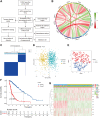
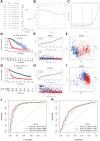
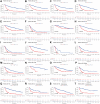
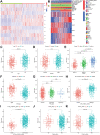


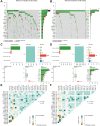
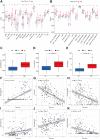

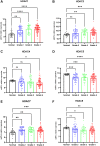
Similar articles
-
Comprehensive analyses reveal the role of histone deacetylase genes in prognosis and immune response in low-grade glioma.PLoS One. 2022 Oct 13;17(10):e0276120. doi: 10.1371/journal.pone.0276120. eCollection 2022. PLoS One. 2022. PMID: 36227941 Free PMC article.
-
Construction and verification of a histone deacetylases-related prognostic signature model for colon cancer.Sci Rep. 2024 Apr 18;14(1):8983. doi: 10.1038/s41598-024-59724-x. Sci Rep. 2024. PMID: 38637684 Free PMC article.
-
Pan-cancer analysis of the transcriptional expression of histone acetylation enzymes in solid tumors defines a new classification scheme for gliomas.Front Immunol. 2025 Jan 21;15:1523034. doi: 10.3389/fimmu.2024.1523034. eCollection 2024. Front Immunol. 2025. PMID: 39906742 Free PMC article.
-
Class II histone deacetylases: structure, function, and regulation.Biochem Cell Biol. 2001;79(3):243-52. Biochem Cell Biol. 2001. PMID: 11467738 Review.
-
[Epigenetic mechanisms and alcohol use disorders: a potential therapeutic target].Biol Aujourdhui. 2017;211(1):83-91. doi: 10.1051/jbio/2017014. Epub 2017 Jul 6. Biol Aujourdhui. 2017. PMID: 28682229 Review. French.
Cited by
-
Molecular Determinants for Photodynamic Therapy Resistance and Improved Photosensitizer Delivery in Glioma.Int J Mol Sci. 2024 Aug 9;25(16):8708. doi: 10.3390/ijms25168708. Int J Mol Sci. 2024. PMID: 39201395 Free PMC article. Review.
-
HDAC3: A Multifaceted Modulator in Immunotherapy Sensitization.Vaccines (Basel). 2025 Feb 13;13(2):182. doi: 10.3390/vaccines13020182. Vaccines (Basel). 2025. PMID: 40006729 Free PMC article. Review.
-
The Epigenetic Modifiers HDAC2 and HDAC7 Inversely Associate with Cancer Stemness and Immunity in Solid Tumors.Int J Mol Sci. 2024 Jul 17;25(14):7841. doi: 10.3390/ijms25147841. Int J Mol Sci. 2024. PMID: 39063083 Free PMC article.
-
FDX1 serves as a prognostic biomarker and promotes glioma progression by regulating the immune response.Aging (Albany NY). 2023 Jun 10;15(11):4963-4985. doi: 10.18632/aging.204772. Epub 2023 Jun 10. Aging (Albany NY). 2023. PMID: 37301546 Free PMC article.
-
Comprehensive Analysis of the Prognostic Implications and Biological Function of HDACs in Liver Hepatocellular Carcinoma.Int J Med Sci. 2024 Oct 28;21(14):2807-2823. doi: 10.7150/ijms.97169. eCollection 2024. Int J Med Sci. 2024. PMID: 39512688 Free PMC article.
References
Publication types
MeSH terms
Substances
LinkOut - more resources
Full Text Sources
Miscellaneous

